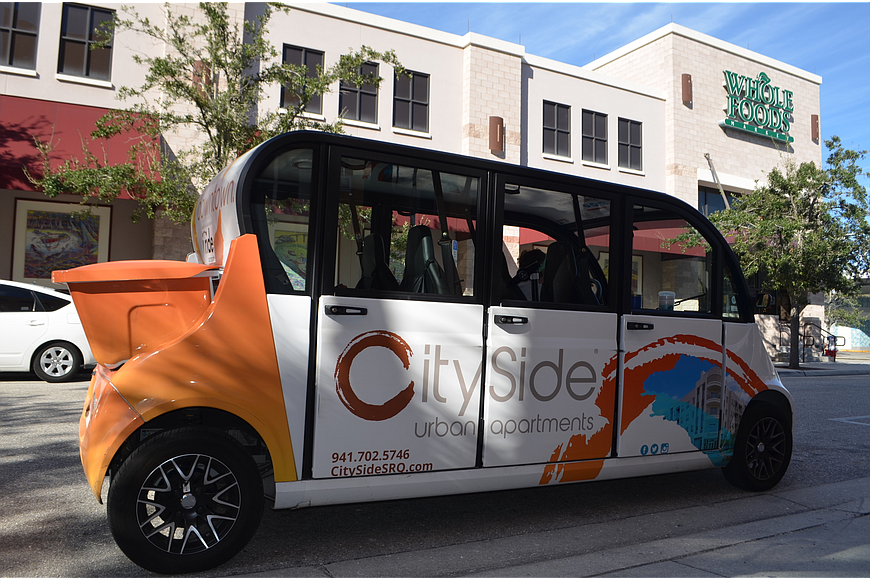- December 13, 2025
-
-
Loading

Loading

A few months after launching the i-Ride Sarasota downtown circulator service, the Gotcha Group ran into a problem: It realized it had to pay its drivers.
The Charleston, S.C.-based transportation company didn’t factor that expense into its original plans for the free transit operation. Now, it says driver payments will make it difficult to continue operating i-Ride independently, even as the Gotcha Group outpaces benchmarks it set for advertising revenue.
As a result, the company is asking the city to consider a long-term subsidy to keep i-Ride running consistently throughout the downtown area. At Monday’s City Commission meeting, representatives for the Gotcha Group asked the board for feedback on the future of the transit service.
The commission expressed mixed feelings about the status of i-Ride. In February 2017, the city agreed to a two-year contract with the Gotcha Group. According to the agreement, the city would pay up to $338,000 to subsidize the transit operation in its first two years. The goal, though, was to make the service self-sustaining by the time the contract was up.
The Gotcha Group agreed to operate a fleet of seven six-seat, low-speed electric vehicles from 11 a.m. to 11 p.m. daily. Riders were supposed to be able to hail the vehicles on the street or request a ride over the phone or through an app, though the app was not functional until recently.
All rides on the service were supposed to be free, and passengers were encouraged to tip their drivers. The operation would generate revenue via advertising on the vehicles.
After launching in March 2017, though, the Gotcha Group said it determined it needed to provide hourly payments to drivers to ensure they got a sufficient wage. In its first year of operation, the i-Ride service paid more than $133,000 to drivers — about $85,000 more than the Gotcha Group budgeted for.
During Monday’s meeting, city officials questioned why the Gotcha Group thought the service could sustain itself based on tips and advertising income alone.
“How could we not know in the beginning that was not going to work?” Mayor Shelli Freeland Eddie said. “That’s a big thing to miss.”
Sean Flood, CEO of the Gotcha Group, said that kind of operation would be viable in some communities. Because of Sarasota’s seasonal population, though, he said i-Ride couldn’t retain high-quality drivers without providing steady payments directly to the drivers.
The company is adjusting the number of vehicles it has on the streets during off-peak hours to reduce expenses. Even with those changes, the Gotcha Group’s projections anticipate a $77,000 deficit for i-Ride in its second year of operation — the final year of the contract with the city.
Flood suggested the city should be willing to consider an additional subsidy for the service going forward. He highlighted that the service has had nearly 50,000 riders in its first year, adding the number could grow as i-Ride continued to establish itself.
“It’s a very different plan than what we originally laid out, but not drastically different,” Flood said. “Paying $75,000 a year to move upward of 50,000 people a year — I think that’s a solid investment. We’re not talking about hundreds of thousands of dollars.”
Commissioner Hagen Brody was critical of the figures the Gotcha Group presented. He was upset the company did not see a path toward sustainability without government assistance and said the city would be better off spending its money on a more ambitious transit operation.
“Coming and asking us for money, I’m not OK with that,” Brody said. “I’m not going to vote for it. I would much rather see a circulator like an open-air trolley that can get people not only around downtown, but to the barrier islands and other destinations here we’re trying to reach.”
Other commissioners placed greater emphasis on the popularity of i-Ride among downtown residents and visitors. Those commissioners asked the Gotcha Group to continue to explore its options for making the service more financially sustainable.
Although they were concerned about the expenses — and critical of the Gotcha Group’s failure to initially set up a functioning phone app — they saw an internal downtown transit service as a helpful piece of a larger transportation network.
“I think it’s an important service that not only the people visit here use, but also the people who live here,” said Commissioner Jen Ahearn-Koch.
Those comments were echoed by representatives for two key downtown groups. John Moran, operations manager of the Downtown Improvement District, called the service a benefit for economic development downtown. He said he could not speak for the board, but he indicated the group could be willing to discuss a potential financial contribution to support i-Ride.
And Patrick Gannon, president of the Downtown Sarasota Condo Association, said residents have responded positively to the transportation service. As a result, he urged officials to find a way to make i-Ride a fixture downtown.
“I suggest continuing to work with them,” Gannon said. “Find those fine-tuning points, and let’s keep this service here.”
The commission took no action Monday, encouraging staff and the Gotcha Group to work together on a way to improve the financial outlook of i-Ride Sarasota. Although some board members remained hopeful the service could find a path to independence, Flood said it would be a challenge to operate without any additional subsidy.
“If you want a different model, then sure, that exists,” Flood said. “Does it exist as a mode of transit that operates for 12 hours a day at this volume? No, it does not.”